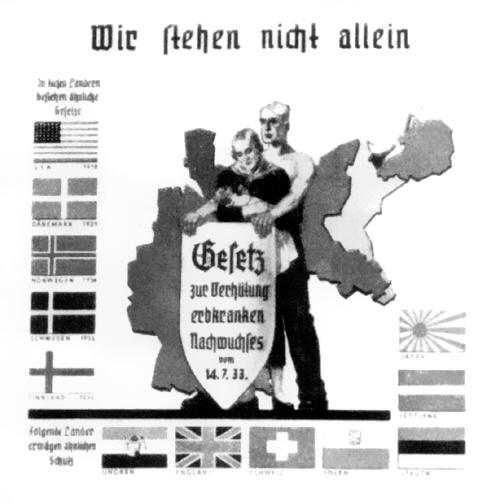This entry is a part of a series.
To clearly understand the material below in context,
you may wish to begin at the beginning with
the introduction to the series.
As chronicled in an earlier entry in this series, the earliest roots of the theories of Eugenics sprang up in Europe. The term itself was coined in 1883 by Englishman Francis Galton, eugenics intended by Galton to mean “well-born” or “good birth.” Galton himself didn’t make much of an effort to apply any “racist” connotations to the theory, but it didn’t take long for other scientists and amateur dabblers to begin nudging it in that direction.
By the late 1800s there were small groups in a number of European countries swapping information and ideas about the topic of eugenics in general. Including in Germany. And around that time the theory jumped the pond to the shores of the United States.
When the experimental discoveries of Mendel about biological inheritance were “rediscovered” and spread throughout scientific communities around 1900 (see the details in another earlier entry in this series), they were quickly folded into the theories of eugenics. In 1903 the organizers of the American Breeders Association (founded at the urging of the US Department of Agriculture to encourage US animal and plant breeders to join their efforts at developing the most effective breeding practices) were already so taken with the new “science” of eugenics, undergirded by Mendelian hereditary principles, that they included a Eugenics Committee in their plans from the very start. The purpose of the committee was not to explore principles of having “well-born” horses and cows and sheep…it was definitely to find applications of the principles of animal breeding to humans.
The establishing resolution declared the committee should “devise methods of recording the values of the blood of individuals, families, people and races.” The resolution specified that the goal was to “emphasize the value of superior blood and the menace to society of inferior blood.” [War Against the Weak, Edwin Black]
As the movement gained steam in the US in the second decade of the 20th century, its development was stymied over in Europe by the realities imposed by the First World War. Particularly in Germany, from the declaration of war in 1914 to the armistice in 1918, all focus of scientific minds had to be primarily on the needs of the military machine. And afterwards, with the nation in shambles, its economy close to totally destroyed, and weighed down by the winning Allies with drastic “war reparations” payments that seemed to have no end, it would take years to recover. Money to pay for research into such an esoteric topic as eugenics just wouldn’t have been available when every penny would be needed to rebuild the infrastructure of the nation.
But the war never came to America’s shores. And no recovery was necessary here, other than juggling some labor issues when the troops came home and jobs were hard to find. So in those years, as mentioned in the previous entry in this series, corporate “philanthropic” money from such entities as the Rockefeller and Carnegie foundations was available to be poured lavishly into the research and projects of American eugenicists. Projects to develop ways to “improve American society”…such as by limiting immigration, sterilizing the “undesirables” already here, and preventing racial intermarriage.
However, one of the guiding principles of the eugenics theory was that the “Nordic” race (the blond, blue-eyed, tall, muscular northern Europeans) were what should be held up as the “ideal” for who should really be populating America. This clearly shows up in eugenics posters.
 And where was one of the “native lands” of such Nordics? Germany. Thus many American eugenicists were strongly drawn to wanting to “fellowship with” and cooperate with scientists from Germany who would be assumed to share their opinion of the superiority of the Nordic race. And thus it was …
And where was one of the “native lands” of such Nordics? Germany. Thus many American eugenicists were strongly drawn to wanting to “fellowship with” and cooperate with scientists from Germany who would be assumed to share their opinion of the superiority of the Nordic race. And thus it was …
…during the 1920s, Carnegie Institution eugenics scientists cultivated deep personal and professional relationships with Germany’s fascist eugenicists. Many of these eugenicists would graduate to become the killing doctors of the Third Reich. [Black, Edwin. Nazi Nexus]
But those Germans had very paltry facilities in which to do their own scientific work, given the shattered infrastructure in Germany for years after the war, and the limited German funds to invest in such work. Not to worry. “American Philanthropy” was able to stretch across the Atlantic.
By the mid-twenties, Germany had achieved preeminence in both legitimate genetic research and spurious racial biology. Germany’s new status arose, in large measure, from its distinguished Kaiser Wilhelm Institutes.
…among the Kaiser Wilhelm Institutes were also several that would soon make their mark in the history of medical murder. The first was the Kaiser Wilhelm Institute for Psychiatry. The second was the Institute for Anthropology, Human Heredity and Eugenics. The third was the Institute for Brain Research. All received funding and administrative support from Americans, especially the Rockefeller Foundation. Indeed, the Rockefeller Foundation helped found the German eugenics program itself.
 Anthropology, Human Heredity, and Eugenics building in Berlin,
Anthropology, Human Heredity, and Eugenics building in Berlin,
built in large part by Rockefeller Foundation funds…
the foundation also kept the Institute going during the depression with funding.
The corporate philanthropy built key eugenic laboratories from the ground up, paid for scientific studies, subsidized travel, financed journals and publication, and extended lucrative fellowships [grants of personal money] to German eugenicists— all to continue research into America’s racist notions of biology. The fruits of this research were to be implemented in Europe.
By 1926, Rockefeller had donated some $ 410,000 —almost $ 4 million in today’s dollars— to hundreds of German researchers. In May 1926, for example, Rockefeller awarded $ 250,000 to the German Psychiatric Institute of the Kaiser Wilhelm Institute, which became the Kaiser Wilhelm Institute for Psychiatry. Among the leading psychiatrists at the German Psychiatric Institute was Ernst Rüdin, who became its director, and eventually an architect of Hitler’s systematic medical repression.
Another in the Kaiser Wilhelm Institute’s complex of eugenic establishments was the Institute for Brain Research. Since 1915, the Institute for Brain Research had operated out of a single room. But everything changed when Rockefeller money arrived in 1929. A grant of $ 317,000 allowed the institute to construct a major building and take center stage in German race biology. During the next several years, the Institute for Brain Research received additional grants from the Rockefeller Foundation. Leading the Brain Institute was—once again— Hitler’s medical henchman, Rüdin. [Nexus]
But even all that money would not have been enough to blast German eugenics into the stratosphere in the 1930s and 1940s. That took the patronage of the Supreme Leader himself. In 1925…
The year after Hitler was imprisoned, [German publisher] Lehmanns published the German translation of American eugenicist Madison Grant’s bestselling volume, The Passing of the Great Race , which had a profound effect on Hitler’s thinking.
Hitler was so steeped in American race science, he even wrote a fan letter to American eugenic leader Madison Grant. Der Führer’s letter called Grant’s eugenics book, The Passing of the Great Race, “my bible.”
… In 1924, when Hitler wrote Mein Kampf, he frequently quoted American eugenic ideology and openly displayed a thorough knowledge of American eugenics and its phraseology. “There is today one state,” Hitler wrote, “in which at least weak beginnings toward a better conception [of immigration] are noticeable. Of course, it is not our model German Republic, but the United States.”
Hitler proudly told his comrades just how closely he followed American eugenic legislation. “I have studied with great interest the laws of several American states concerning prevention of reproduction by people whose progeny would, in all probability, be of no value or be injurious to the racial stock,” he told a fellow Nazi.
 Wir stehen nicht allein: “We do not stand alone”.
Wir stehen nicht allein: “We do not stand alone”.
Nazi propaganda poster from 1936,
supporting Nazi Germany’s 1933 Law for the Prevention of
Hereditarily Diseased Offspring
(their compulsory sterilization law).
The couple is in front of a map of Germany,
surrounded by the flags of nations which had enacted (to the left)
or were considering (bottom and to the right) similar legislation. [Wiki]
[Note the US flag at the top of the list.]
Hitler merely exchanged the American term “Nordic” for “Germanic” or “Aryan” and then medicalized his pre-existing virulent anti-Semitism and fascist nationalism, to formulate the concept of the Master Race he deified in Mein Kampf. [Nexus]
Yes, Madison Grant’s “Great Race” became Hitler’s “Master Race.” And America’s governmental policies that had been ram-rodded through with the help of the eugenicists of America became “models” for the Nazis.
So when massive amounts of American philanthropic dollars came pouring in to fund eugenic German scientists and institutions, the Germans were able to immediately “invest” it in the crash development of a real world eugenic blitzkrieg, as opposed to the slow, moderate, somewhat “pie in the sky” dreams of the American eugenicists. Yes, the Americans were able to get the US government to do the baby steps of immigration limits, forced sterilization on a very small scale, and anti-miscegenation laws in some areas of the country. But they were painfully aware that a democratic nation would be difficult to “steer” with any speed toward the kind of “final solution” they all actually hoped for. The Nazis, on the other hand, could pull out all stops and careen full speed ahead.
Hitler’s arrival on the eugenic scene changed the entire partnership between German and American eugenicists. During the first two decades of the twentieth century, America had shown Germany the way, treating the struggling German movement with both parental fascination and Nordic admiration. But when Hitler emerged in 1924, the relationship quickly shifted to an equal partnership.
National Socialism promised a sweeping hereditary revolution, establishing dictatorial racial procedures that American activists could only dream of. During the period between wars, the American movement viewed National Socialism as a rising force that could successfully, if empowered, impose a new biological world order. Nazi eugenicists promised to dispense with the niceties of democratic rule.
So even if America’s tower of legislation, well-funded research and entrenched bureaucratic programs still monopolized the world of applied eugenics in the 1920s, National Socialism promised to own the next decade. American eugenicists welcomed the idea. [Nexus]
We’ll examine the Nazi/American eugenic connection more closely in the next entry in this series:
The New Mt. Sinai
